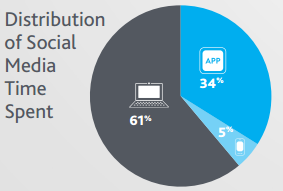Social media content provides both marketers and consumers with a plethora of benefits. Internet users access their social accounts to keep in touch with friends and family, but also maintain a sense of awareness of brands they purchase products or services from, as well as current events. In fact, Americans increased the amount of time they dedicate toward social networks in 2012, which should encourage brands to consider their social media marketing efforts as vital to future success.
 In NM Incite’s “The Social Media Report,” social users divided their time across three points of access: desktop, mobile applications and mobile web. Data shows that 61 percent of survey respondents manage their social accounts via their PCs, 34 percent use mobile apps and 5 percent prefer the mobile web. Of the internet users visiting social platforms in the United States, Facebook accounted for 27 billion minutes in 2012 (up 61 percent year-over-year), and Twitter users spent 36 billion minutes Tweeting this year, an increase of 48 percent.
In NM Incite’s “The Social Media Report,” social users divided their time across three points of access: desktop, mobile applications and mobile web. Data shows that 61 percent of survey respondents manage their social accounts via their PCs, 34 percent use mobile apps and 5 percent prefer the mobile web. Of the internet users visiting social platforms in the United States, Facebook accounted for 27 billion minutes in 2012 (up 61 percent year-over-year), and Twitter users spent 36 billion minutes Tweeting this year, an increase of 48 percent.
Consumers use social networks for a variety of reasons, but a new study from SocialVibe, conducted by GfK, discovered that 70 percent of survey respondents make purchases after engaging with brands in a social manner. Twenty-two percent of social users said they still don’t see the value of connecting with companies through sites like Facebook. The division suggests marketers and consumers have a long way to go before establishing similar perspectives surrounding social media content.
SocialVibe discovered that 19 percent of consumers often purchase products due to social interactions while 29 percent said they sometimes buy items because of social cues. Perhaps the most powerful data point published in the SocialVibe report is that 61 percent of social media users first consider buying products from brands they follow online. Businesses that promote what they sell via social channels increase their odds of improving sales.
The types of updates social users prefer ranged from receiving special offers (20 percent) to current news posts (16 percent) to weekly updates (23 percent) to finding new content (17 percent). As U.S. internet users dedicate more time to social media, SocialVibe’s data suggests marketers should publish a wide range of branded content to their accounts. Whether posting weekly status updates or more in-depth custom content, brands that take social engagement seriously have greater odds of increasing web sales, and maintaining higher engagement rates from their loyal customer bases.




